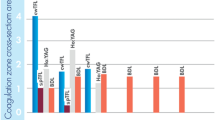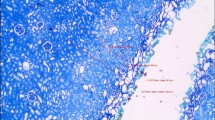Abstract
Purpose
To evaluate the ablation capacity using two Thulium fiber lasers (TFL) in a porcine kidney model.
Methods
All tissue samples were mounted on a motorized stage for a precise speed of cutting. A continuous wave (cw) TFL and a super pulsed (SP) TFL were used at power settings of 60 and 120 W with 200 and 600 µm laser fibers. After lactate dehydrogenase staining, histological evaluation was performed to measure the vaporization volume (VV), ablation depth (AD), thermo-mechanical damage zones (TMZ), coagulation zones (CZ) and the carbonization grade (CG).
Results
At 120 W, no significant differences were seen between 200 and 600 µm fibers utilizing the cw TFL regarding VV (24.6 vs. 28.2 mm3/s), AD (5.6 vs. 5.7 mm), TMZ (0 vs. 0 mm2) and CZ (18.1 vs. 12.3 mm2). Using the SP TFL, no significant differences between both fiber diameters with regard to VV (4 vs. 6.2 mm3/s), AD (2.7 vs. 3.4 mm), TMZ (1 vs. 2.6 mm2) and CZ (3.1 vs. 2.2 mm2) at 120 W were found, respectively. However, the VV of the cw TFL at 60 W was significantly less compared to 120 W using 200 and 600 µm fibers, respectively, whereas the SP TFL did not show significant differences between 60 and 120 W with regard to VV. SP TFL showed a consistently lower CG compared to cw TFL.
Conclusions
This experiment suggests that there is no significant difference using 200 or 600 µm laser fibers in cw or SP TFLs. However, the cw TFL produces a coagulation zone three to five times larger than the SP TFL regardless of the fiber diameter.


Similar content being viewed by others
References
Bach T, Muschter R, Sroka R et al (2012) Laser treatment of benign prostatic obstruction: basics and physical differences. Eur Urol 61:317–325. https://doi.org/10.1016/j.eururo.2011.10.009
Bach T, Wendt-Nordahl G, Michel MS et al (2009) Feasibility and efficacy of Thulium:YAG laser enucleation (VapoEnucleation) of the prostate. World J Urol 27:541–545. https://doi.org/10.1007/s00345-008-0370-0
Becker B, Herrmann TRW, Gross AJ, Netsch C (2018) Thulium vapoenucleation of the prostate versus holmium laser enucleation of the prostate for the treatment of large volume prostates: preliminary 6-month safety and efficacy results of a prospective randomized trial. World J Urol. https://doi.org/10.1007/s00345-018-2321-8
Enikeev D, Okhunov Z, Rapoport L et al (2018) Novel thulium fiber laser for enucleation of prostate: a retrospective comparison with open simple prostatectomy. J Endourol. https://doi.org/10.1089/end.2018.0791
Yaroslavsky I, Kovalenko A, Arkhipova V et al (2018) Comparison of a novel 450-nm laser with Ho:YAG (2100 nm), Tm fiber (1940 nm), and KTP (532 nm) lasers for soft-tissue ablation. In: Kang HW, Chan KF (eds) Therapeutics and diagnostics in urology 2018. SPIE, San Francisco, p 15
Peters K, Michel MS, Matis U, Häcker A (2006) The isolated perfused porcine kidney model for investigations concerning surgical therapy procedures. Altex 23:203–207
Bach T, Huck N, Wezel F et al (2010) 70 vs 120 W thulium:yttrium-aluminium-garnet 2 micron continuous-wave laser for the treatment of benign prostatic hyperplasia: a systematic ex vivo evaluation. BJU Int 106:368–372. https://doi.org/10.1111/j.1464-410X.2009.09059.x
Seitz M, Bayer T, Ruszat R et al (2009) Preliminary evaluation of a novel side-fire diode laser emitting light at 940 nm, for the potential treatment of benign prostatic hyperplasia: ex vivo and in vivo investigations. BJU Int 103:770–775. https://doi.org/10.1111/j.1464-410X.2008.08066.x
Sherwood ME, Flotte TJ (2007) Improved staining method for determining the extent of thermal damage to cells. Lasers Surg Med 39:128–131. https://doi.org/10.1002/lsm.20450
Johnson DE, Cromeens DM, Price RE (1992) Use of the holmium:YAG laser in urology. Lasers Surg Med 12:353–363
Emiliani E, Talso M, Haddad M et al (2018) The true ablation effect of holmium YAG laser on soft tissue. J Endourol 32:230–235. https://doi.org/10.1089/end.2017.0835
Gross AJ, Netsch C, Knipper S et al (2013) Complications and early postoperative outcome in 1080 patients after thulium vapoenucleation of the prostate: results at a single institution. Eur Urol 63:859–867. https://doi.org/10.1016/j.eururo.2012.11.048
Enikeev D, Glybochko P, Rapoport L et al (2018) Impact of endoscopic enucleation of the prostate with thulium fiber laser on the erectile function. BMC Urol 18:87. https://doi.org/10.1186/s12894-018-0400-1
Herrmann TRW, Liatsikos EN, Nagele U et al (2012) EAU guidelines on laser technologies. Eur Urol 61:783–795. https://doi.org/10.1016/j.eururo.2012.01.010
Iacono F, Prezioso D, Di Lauro G et al (2012) Efficacy and safety profile of a novel technique, ThuLEP (Thulium laser enucleation of the prostate) for the treatment of benign prostate hypertrophy. Our experience on 148 patients. BMC Surg 12(Suppl 1):S21. https://doi.org/10.1186/1471-2482-12-S1-S21
Kronenberg P, Traxer O (2014) In vitro fragmentation efficiency of holmium: yttrium-aluminum-garnet (YAG) laser lithotripsy–a comprehensive study encompassing different frequencies, pulse energies, total power levels and laser fibre diameters. BJU Int 114:261–267. https://doi.org/10.1111/bju.12567
Kronenberg P, Traxer O (2015) Update on lasers in urology 2014: current assessment on holmium:yttrium-aluminum-garnet (Ho:YAG) laser lithotripter settings and laser fibers. World J Urol 33:463–469. https://doi.org/10.1007/s00345-014-1395-1
Wezel F, Häcker A, Gross AJ et al (2010) Effect of pulse energy, frequency and length on holmium:yttrium-aluminum-garnet laser fragmentation efficiency in non-floating artificial urinary calculi. J Endourol 24:1135–1140. https://doi.org/10.1089/end.2010.0115
Finley DS, Petersen J, Abdelshehid C et al (2005) Effect of holmium:YAG laser pulse width on lithotripsy retropulsion in vitro. J Endourol 19:1041–1044. https://doi.org/10.1089/end.2005.19.1041
Fried NM, Murray KE (2005) High-power thulium fiber laser ablation of urinary tissues at 1.94 microm. J Endourol 19:25–31. https://doi.org/10.1089/end.2005.19.25
Chen C-H, Chiang P-H, Lee W-C et al (2012) High-intensity diode laser in combination with bipolar transurethral resection of the prostate: a new strategy for the treatment of large prostates (> 80 ml). Lasers Surg Med 44:699–704. https://doi.org/10.1002/lsm.22081
Funding
No funding was obtained.
Author information
Authors and Affiliations
Contributions
All authors whose names appear on the submission have contributed sufficiently to the scientific work and therefore share collective responsibility and accountability for the results. BB: project development, data collection, data analysis, manuscript writing/editing. DE: project development, data collection, data analysis, manuscript editing. PG: project development, manuscript editing. LR: project development, manuscript editing. MT: project development, data collection, data analysis, manuscript editing. AJG: project development, manuscript editing. VV: project development, data collection, data analysis. TRWH: project development, manuscript editing. CN: project development, data collection, data analysis, manuscript editing.
Corresponding author
Ethics declarations
Conflict of interest
The authors declare that they have no conflict of interest.
Ethical approval
This article does not contain any studies with human participants or animals performed by any of the authors.
Informed consent
Informed consent was not necessary in this study.
Additional information
Publisher's Note
Springer Nature remains neutral with regard to jurisdictional claims in published maps and institutional affiliations.
Rights and permissions
About this article
Cite this article
Becker, B., Enikeev, D., Glybochko, P. et al. Effect of optical fiber diameter and laser emission mode (cw vs pulse) on tissue damage profile using 1.94 µm Tm:fiber lasers in a porcine kidney model. World J Urol 38, 1563–1568 (2020). https://doi.org/10.1007/s00345-019-02944-y
Received:
Accepted:
Published:
Issue Date:
DOI: https://doi.org/10.1007/s00345-019-02944-y




